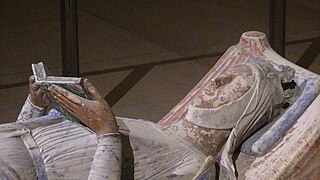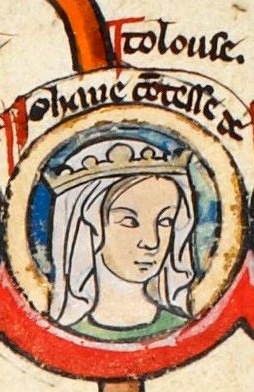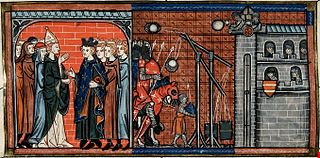Related Research Articles

Eleanor of Aquitaine was Duchess of Aquitaine in her own right from 1137 to 1204, Queen of France from 1137 to 1152 as the wife of King Louis VII, and Queen of England from 1154 to 1189 as the wife of King Henry II. As the heiress of the House of Poitiers, which controlled much of southwestern France, she was one of the wealthiest and most powerful women in Western Europe during the High Middle Ages. Militarily, she was a key leading figure in the Second Crusade, and in a revolt in favour of her son. Culturally, she was a patron of poets such as Wace, Benoît de Sainte-Maure, and Bernart de Ventadorn, and of the arts of the High Middle Ages.

Richard I was King of England from 1189 until his death in 1199. He also ruled as Duke of Normandy, Aquitaine, and Gascony; Lord of Cyprus; Count of Poitiers, Anjou, Maine, and Nantes; and was overlord of Brittany at various times during the same period. He was the third of five sons of Henry II of England and Eleanor of Aquitaine and seemed unlikely to become king, but his two elder brothers predeceased their father. Richard is known as Richard Cœur de Lion or Richard the Lionheart because of his reputation as a great military leader and warrior. The troubadour Bertran de Born also called him Richard Oc-e-Non, possibly from a reputation for terseness.

Louis VII, called the Younger, or the Young, was King of the Franks from 1137 to 1180. He was the son and successor of King Louis VI and married Duchess Eleanor of Aquitaine, one of the wealthiest and most powerful women in western Europe. The marriage temporarily extended the Capetian lands to the Pyrenees.

Geoffrey II was Duke of Brittany and 3rd Earl of Richmond between 1181 and 1186, through his marriage to Constance, Duchess of Brittany. Geoffrey was the fourth of five sons of Henry II of England and Eleanor, Duchess of Aquitaine.

Arthur I was 4th Earl of Richmond and Duke of Brittany between 1196 and 1203. He was the posthumous son of Geoffrey II, Duke of Brittany, and Constance, Duchess of Brittany. His father, Geoffrey, was the son of Henry II, King of England.

The Duchy of Brittany was a medieval feudal state that existed between approximately 939 and 1547. Its territory covered the northwestern peninsula of Europe, bordered by the Atlantic Ocean to the west, and the English Channel to the north. It was also less definitively bordered by the river Loire to the south, and Normandy, and other French provinces, to the east. The Duchy was established after the expulsion of Viking armies from the region around 939. The Duchy, in the 10th and 11th centuries, was politically unstable, with the dukes holding only limited power outside their own personal lands. The Duchy had mixed relationships with the neighbouring Duchy of Normandy, sometimes allying itself with Normandy, and at other times, such as the Breton–Norman War, entering into open conflict.
Constance was Duchess of Brittany from 1166 to her death in 1201 and Countess of Richmond from 1171 to 1201. Constance was the daughter of Duke Conan IV by his wife, Margaret of Huntingdon, a sister of the Scottish kings Malcolm IV and William I.

Eleanor, Fair Maid of Brittany, also known as Damsel of Brittany, Pearl of Brittany, or Beauty of Brittany, was the eldest daughter of Geoffrey II, Duke of Brittany, and Constance, Duchess of Brittany. Her father, Geoffrey, was the fourth son of Henry II, King of England.

The now-extinct title of Earl of Richmond was created many times in the Peerage of England. The earldom of Richmond was initially held by various Breton nobles; sometimes the holder was the Breton duke himself, including one member of the cadet branch of the French Capetian dynasty. The historical ties between the Duchy of Brittany and this English earldom were maintained ceremonially by the Breton dukes even after England ceased to recognize the Breton dukes as earls of England and those dukes rendered homage to the King of France, rather than the English crown. It was then held either by members of the English royal families of Plantagenet and Tudor, or English nobles closely associated with the English crown. It was eventually merged into the English crown during the reign of Henry VII of England and has been recreated as a Dukedom.

The term Angevin Empire describes the possessions held by the House of Plantagenet during the 12th and 13th centuries, when they ruled over an area covering roughly all of present-day England, half of France, and parts of Ireland and Wales, and had further influence over much of the remaining British Isles. It may be described as an early example of a composite monarchy. The empire was established by Henry II of England, who succeeded his father Geoffrey as Duke of Normandy and Count of Anjou. Henry married Eleanor of Aquitaine in 1152, acquiring the Duchy of Aquitaine, and inherited his mother Empress Matilda's claim to the English throne, succeeding his rival Stephen in 1154. Although their title of highest rank came from the Kingdom of England, the Plantagenets held court primarily on the continent at Angers in Anjou, and at Chinon in Touraine.
Alys of France, Countess of Vexin, known in English as "Alice", was a French princess, the daughter of Louis VII, King of France and his second wife, Constance of Castile.

The House of Plantagenet was a royal house which originated in the French County of Anjou. The name Plantagenet is used by modern historians to identify four distinct royal houses: the Angevins, who were also Counts of Anjou; the main line of the Plantagenets following the loss of Anjou; and the houses of Lancaster and York, the Plantagenets' two cadet branches. The family held the English throne from 1154, with the accession of Henry II, until 1485, when Richard III died.
Alice of France was countess consort of Blois by marriage to Theobald. She served as regent of Blois during Theobald's absence from in 1190–1191, and during the minority of their son Louis from 1191 until 1197. The daughter of Eleanor of Aquitaine and Louis VII of France, she was the sister of Marie of France and the half-sister of: William IX, Henry the Young King, Richard I, Geoffrey of Brittany, Matilda of England, Eleanor of England, Joan of England, John of England; Margaret of France, Alys of France, Agnes of France, Philip II of France; and the stepdaughter of Henry II of England, and Constance of Castile, and Adela of Champagne.

Joan of England was a Queen of Sicily and countess consort of Toulouse. She was the seventh child of Henry II, King of England, and Eleanor, Duchess of Aquitaine. From her birth, she was destined to make a political and royal marriage. She married William II of Sicily and later Raymond VI, Count of Toulouse, two very important and powerful figures in the political landscape of Medieval Europe.
Geoffrey VI was Count of Nantes from 1156 to 1158. He was also known as Geoffrey of Anjou and Geoffrey FitzEmpress. He was the son of Geoffrey Plantagenet and Empress Matilda. His brothers were Henry II of England and William FitzEmpress.
Events from the 1150s in England.

Henry II, also known as Henry Curtmantle, was King of England from 1154 until his death in 1189. During his reign he controlled England, substantial parts of Wales and Ireland, and much of France, an area that altogether was later called the Angevin Empire, and also held power over Scotland and the Duchy of Brittany.

The siege of La Rochelle of 1224 was the decisive engagement in the campaign between the Capetians and the Plantagenets for control of Poitou. French royal forces commanded by Capetian king Louis VIII laid siege to the strategic port of La Rochelle and its garrison of Poitevin and English soldiers commanded by Savari de Mauléon. The port had long been a staging ground for Plantagenet efforts to regain their continental lands lost to the French crown since 1203. The siege lasted from July to August 1224, and resulted in La Rochelle's citizens surrendering the city to Louis after the failure of English relief to emerge. The siege of La Rochelle was the crowning event of the Capetian conquest of Poitou from the Plantagenets. With Poitou in Capetian hands, only Gascony remained under Plantagenet rule on the continent.

The Angevin kings of England were Henry II and his sons, Richard I and John, who ruled England from 1154 to 1216. They were related to the Norman kings of England through Matilda, the daughter of Henry I and mother of Henry II. They were also related to the earlier Anglo-Saxon kings of England through Matilda's great-great-great grandfather, Aethelred the Unready. Their descendants, the main line of Plantagenets, continued to rule England until 1485; some historians make no distinction between the Angevins and the Plantagenets, while others consider John's son Henry III to be the first Plantagenet king.

The Capetian–Plantagenet rivalry was a series of conflicts and disputes that covered a period of 100 years (1159–1259) during which the House of Capet, rulers of the Kingdom of France, fought the House of Plantagenet, rulers of the Kingdom of England, over the Plantagenet-held Angevin Empire which at its peak covered around half of the territory within France. Some historians refer to this series of events as the "First Hundred Years' War".